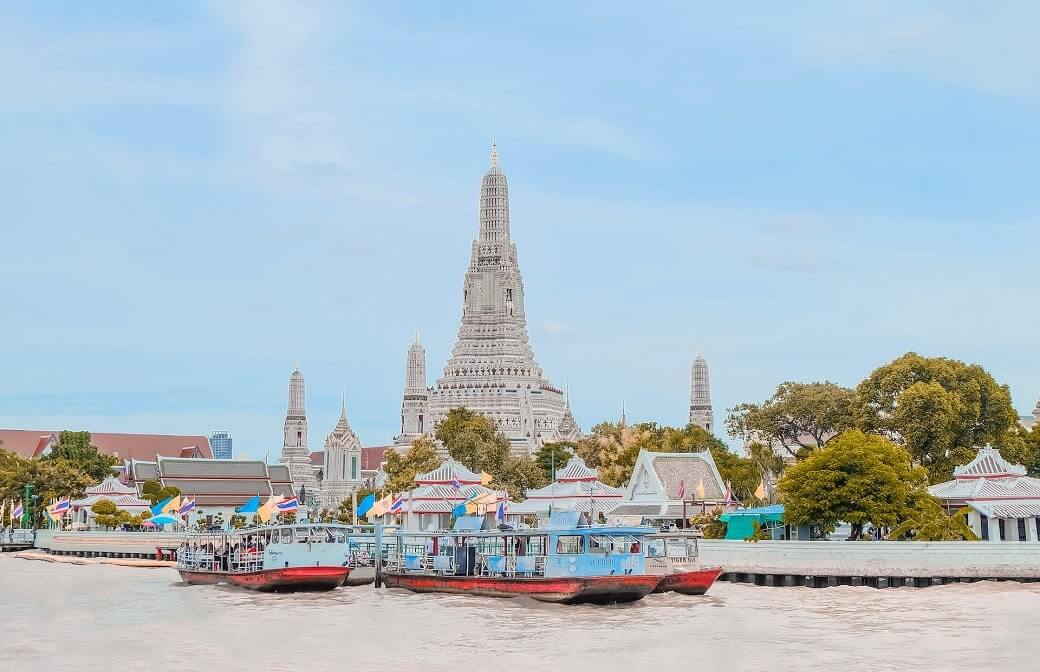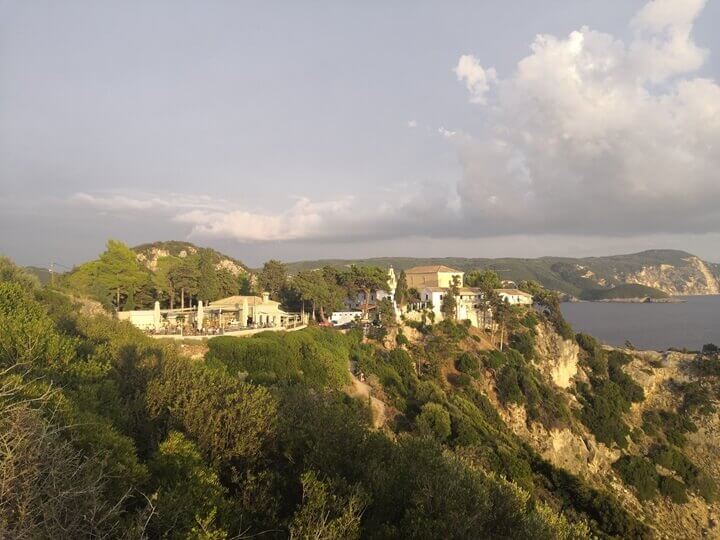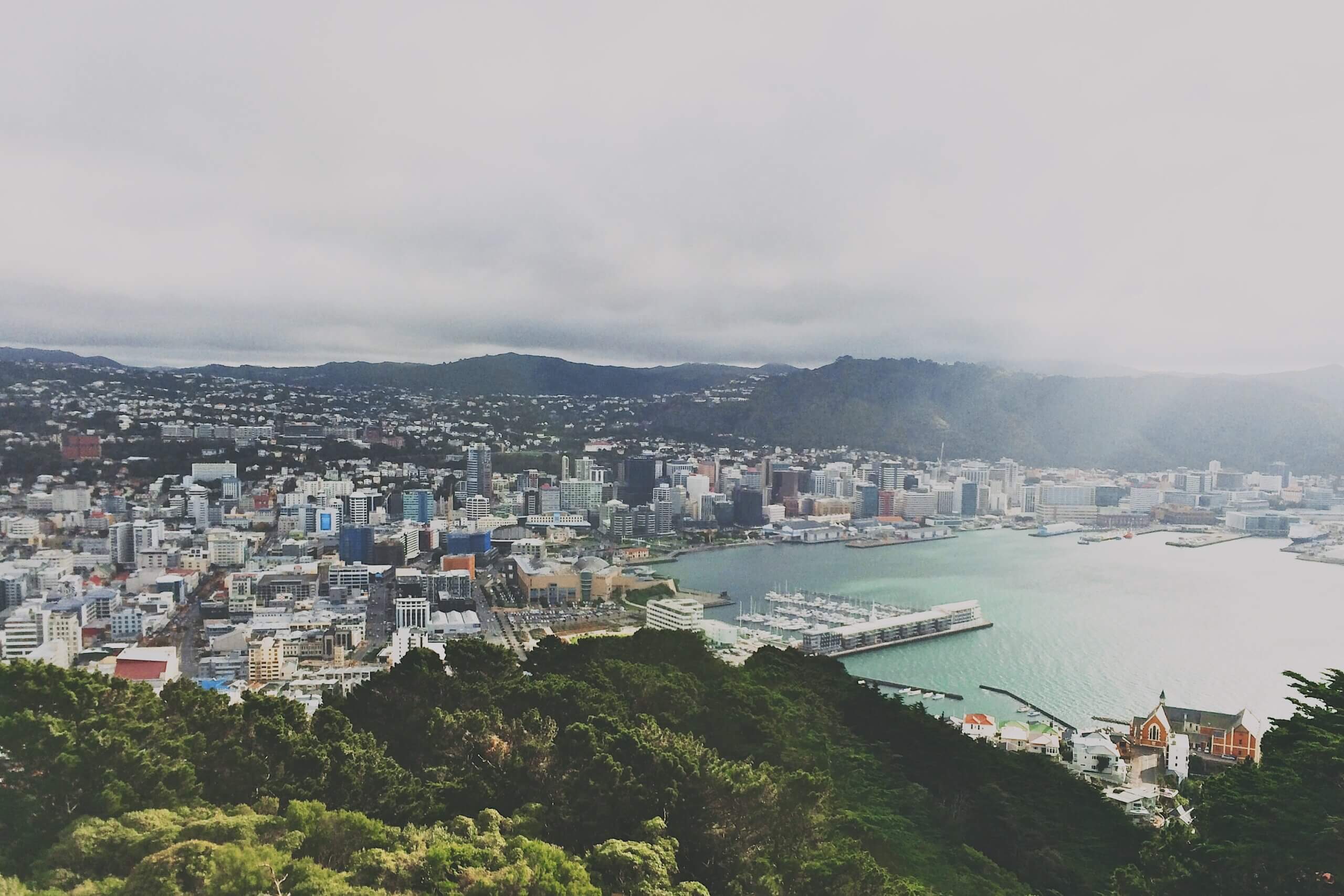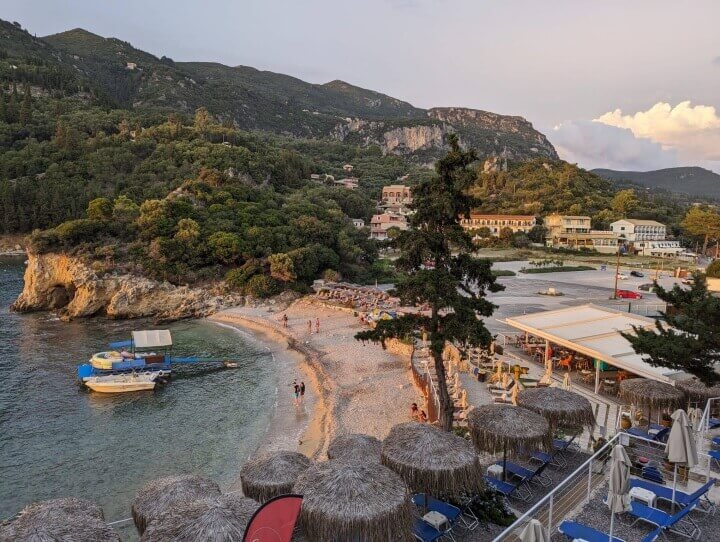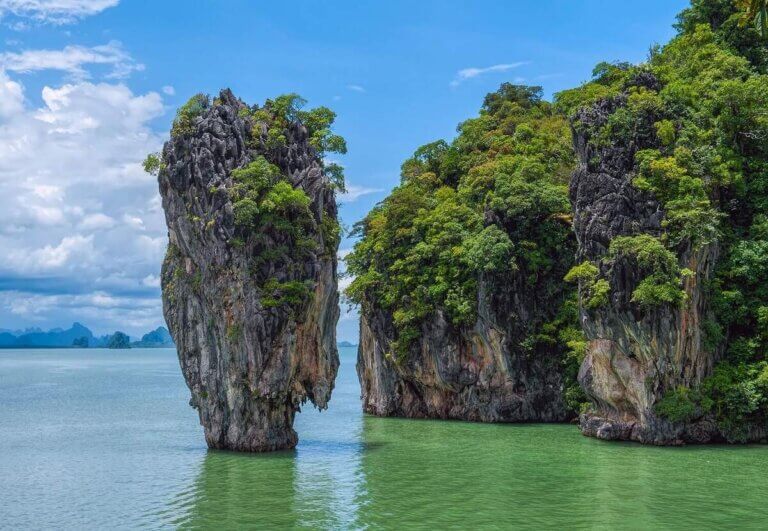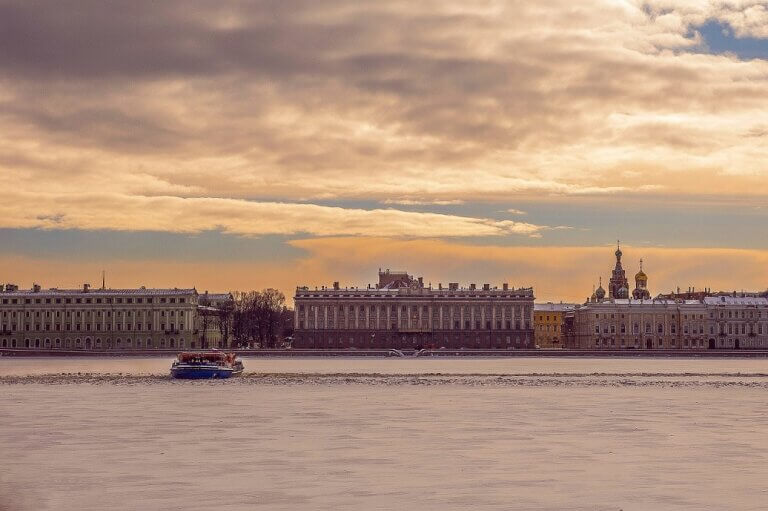Is Bangkok Worth Visiting in 2024? 17 Best Reasons to Visit Bangkok
Wondering if Thailand’s famous capital, Bangkok, is worth visiting? This guide offers the best reasons why you should visit this bustling metropolis.
The Thai capital is a popular tourist destination that attracts millions of visitors every year. From stunning temples and delicious street food to high-end rooftop bars and amazing shopping, there is something for every taste and budget.
Bangkok is a city of wild contrasts where century-old traditions seamlessly blend with the trappings of modernity. You can often find shantytowns right next to epic skyscrapers. Buddhist shrines pop up next to mega malls built in the name of consumerism. Unassuming street food stalls still provide sustenance for young professionals in the swanky business district.
Just like with any other destination, there are also downsides to visiting Bangkok. Your first time in the city can be overwhelming. It is vast and chaotic, and the never-ending traffic jams are not a myth.
However, if you give it a chance, you will discover many quieter corners and hidden gems. Don’t worry, this guide on why Bangkok is worth visiting will help you navigate this urban jungle.
Disclosure: Some of the links below are affiliate links, which means that at no additional cost to you, I may earn a small commission if you click through and make a purchase. Please note, I only recommend products and services that I know and love. Read full Privacy Policy here.
Is Bangkok Worth Visiting in 2024?
In short, yes, Bangkok is worth visiting, and there are many reasons why it is a great destination for different types of travellers. In this article, I’m sharing my personal reasons for loving Bangkok. They are:
- The majestic Grand Palace
- Magnificent Wat Pho
- Beautiful Wat Arun
- It’s an affordable destination
- Travel back in time at Jim Thompson House
- Epic Chinatown
- Amazing shopping malls
- Fascinating floating markets
- Dazzling rooftop bars
- Delicious Thai food
- Romantic cruises along the Chao Phraya River
- Infamous Khao San Road
- Tranquillity of Lumphini Park
- Relaxing Thai massages
- Hub for Thailand and South East Asia travel
- Hot all year round
- Convenient and easy to travel
This article also includes tips and recommendations on the best times to visit, getting around the city, and where to stay to help you plan your own trip. I hope that you are inspired to discover what Bangkok has to offer for yourself.
The Majestic Grand Palace

A visit to The Grand Palace is undoubtedly one of the reasons why Bangkok is worth visiting. Established in 1782, this historical complex was the official residence for the Thai royal family until the early 20th century. It incorporates living quarters, government buildings, halls and pavilions surrounded by protective walls.
The Grand Palace complex is also home to the Temple of the Emerald Buddha (Wat Phra Kaew). This significant temple houses a revered Buddha image entirely carved from a single block of jade. To this day Wat Phra Kew remains a pilgrimage destination for Buddhists.
The palace brings together traditional Thai architecture and Western influences. Many of the buildings within the complex boast intricate carvings, mosaics, murals, ceramic tiles and gold leaf cladding. If you happen to visit on a bright day, these decorative features will glisten beautifully in the sun.
I was fortunate to visit the Grand Palace just after Thailand started to cautiously open after the pandemic in late 2021. Although the complex was busy, the crowds were not overwhelming, and it was easy to find quieter corners to simply take in the architectural beauty.
However, this is not usually the case. The Grand Palace is one of the most popular landmarks in Bangkok, so expect it to be extremely busy, especially in the high season. To beat the crowds and the scorching heat, head there as early as possible.
Entry to the palace is 500 baht (15 USD) per person. Keep in mind that the palace is also a religious sight. Make sure to dress modestly and cover your knees and shoulders. You can purchase a sarong at the entrance to the palace if needed.
Getting to The Grand Palace
The closest MRT station is Sanam Chai. It’s just a 15-minute walk away from the palace. You can also take the Chao Phraya Express boat to the Tha Tien pier. The Grand Palace is just a short walk away.
Guided Tours
If you would like to learn more about the Grand Palace on your visit, check out one of these tours:
Magnificent Wat Pho
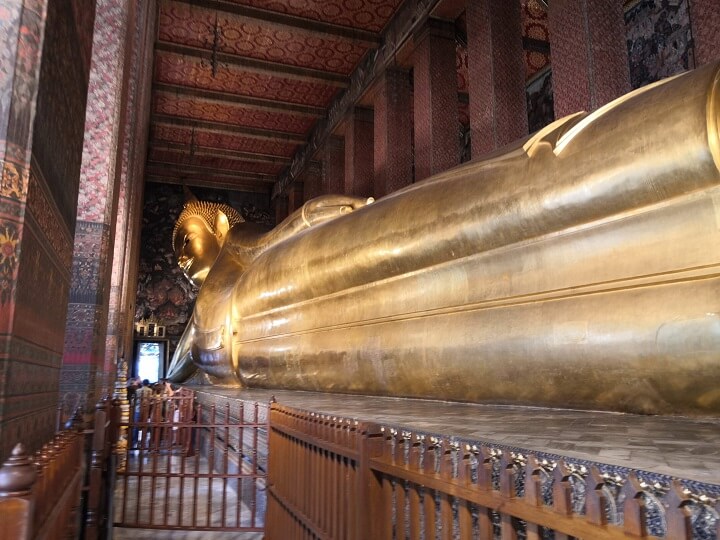
Another famous landmark worth adding to your list is Wat Pho, also known as the Temple of the Reclining Buddha. Established in the 16th century, this is one of the oldest and largest temple complexes in the Thai capital.
Wat Pho is famous for being the home of the giant reclining Buddha figure covered in gold leaf. At 46 meters long and 15 meters high, it is certainly an impressive site. Visitors can walk around it to appreciate its scale.
But there is more to Wat Pho than the reclining Buddha. Make sure to explore the grounds within the temple complex. You will get to see stupas, intricate murals, quiet chapels and over 1,000 Buddha statues. Aside from the reclining Buddha’s pavilion which does get crowded, the rest of Wat Pho is relatively quiet. It’s a great place to simply wander and take it the beautiful surroundings.
Wat Pho also houses a traditional Thai massage and medicine school. If you are looking to experience a Thai massage, you’ll be in good hands there.
Entry to Wat Pho is 200 baht (6 USD) which includes a complimentary bottle of water. Just like at The Grand Palace, make sure to dress modestly, covering your shoulders and knees.
Getting to Wat Pho
Wat Pho is located just a short walk away from The Grand Palace. You can easily visit both landmarks in one day. If you are only visiting Wat Pho, it is also accessible from the Tha Tien pier and Sanam Chai MRT station.
Guided Tours
There are English-speaking tour guides available right at Wat Pho. A tour costs 200 or 400 baht (6 or 12 USD), depending on the size of the group. Alternatively, you can join one of these highly rated guided tours:
- Grand Palace, Wat Arun and Wat Pho Evening Tour
- Wat Pho and Wat Arun Guided Walking Tour
- Grand Palace, Wat Pho, and Wat Arun Private Tour
Beautiful Wat Arun
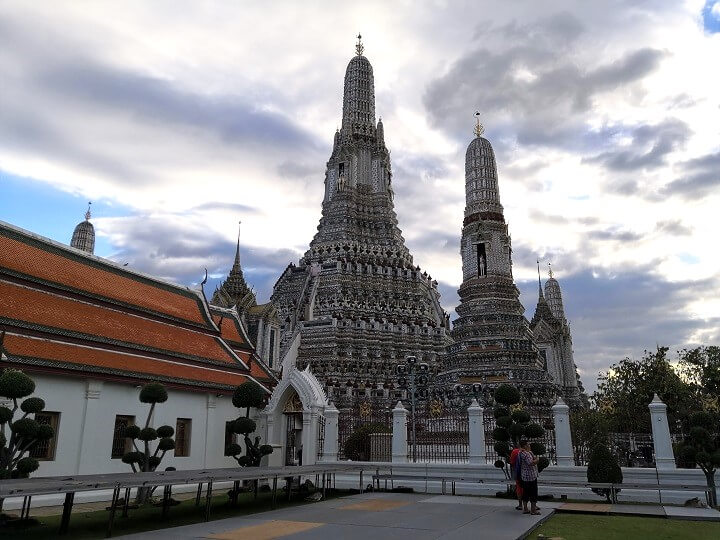
Just across the river from The Grand Palace and Wat Pho you will find Wat Arun, the Temple of Dawn. There are many stunning temples in Bangkok that are worth visiting, but Wat Arun is undoubtedly the jewel in the city’s crown.
It is especially beautiful at night when it’s lit up. However, it’s worth taking some time for a daytime visit to explore the temple in more detail.
The first iteration of the temple was built in the 17th century. It was expanded and extensively renovated in later centuries. Today, Wat Arun is considered one of the most beautiful temples in Bangkok. Its unique design features a 70-meter Khmer-style spire and intricate Chinese porcelain mosaics laid out in elegant floral patterns. The latter is the reason why the temple glistens so beautifully in the sun.
You can climb the central spire part-way to enjoy the views over the nearby area. The steps are steep, so take extra care when attempting the climb. Going up and down is challenging.
Entry to Wat Arun costs 100 baht (3 USD) per person. As this is still very much a religious sight, you need to adhere to the usual modest dress code.
Getting to Wat Arun
If you are going to Wat Arun after a visit to the Grand Palace or Wat Pho, head to the Tha Tien Pier. There is a regular boat service that goes to the other side of the river. The trip costs 4 baht (0.12 USD).
It’s an Affordable Destination
Visitors from countries with stronger purchasing power often find that Bangkok is worth visiting because it is an affordable destination compared to other global cities such as London or Tokyo. However, it’s important to remember that, although your earnings can stretch further in Bangkok, many locals do not enjoy the same privileges.
The average salary in Bangkok is only US $650 a month, which doesn’t stretch very far. Many people have to survive on much less. Low wages are one of the reasons why the cost of living in Bangkok, and in the wider country, seems so low to foreigners.
Although Bangkok is more expensive than other parts of South East Asia, tourists can still find a bed in a dorm for as little as US $6, or a budget hotel room for around US $30 a night. Luxury in Bangkok is also more affordable, and you can find a five-star hotel for about US $100 a night.
When it comes to food, street food in Bangkok is cheap, plentiful, and delicious. You can get a meal for $1.00 – $3.00 at a street food stall. Cafes and restaurants are more expensive, with a meal for two costing between US $10 and $50.
Transport in Bangkok is also quite affordable, with bus tickets costing about US $0.20 per person, while a journey on the BTS or metro train will set you back between $0.50 and $1.50. Visitors from countries like the US, Europe, or Australia will find local taxis relatively inexpensive as well.
Travel Back in Time at Jim Thompson House
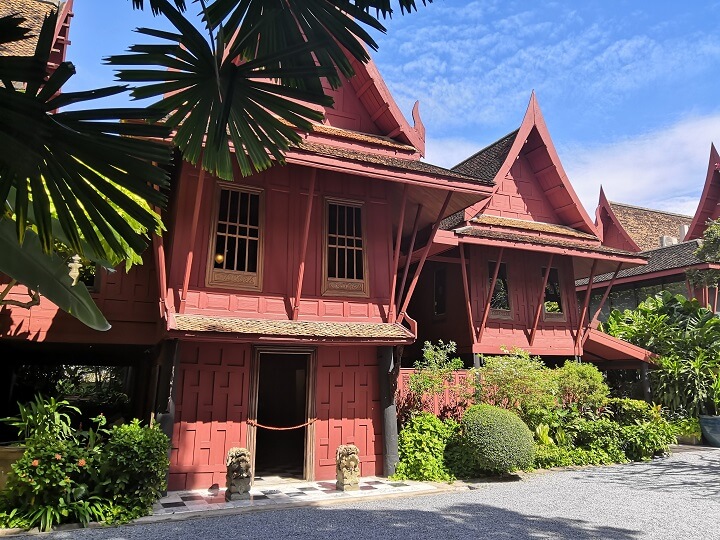
If you would like to experience traditional Thai interiors and learn about a mysterious historic figure, make sure to add Jim Thompson House to your list of things to do in Bangkok.
Jim Thompson is a high-end Thai brand specialising in silk products from clothing to homewares. It was founded by American businessman and, reportedly, spy, Jim Thompson. His work helped to revive the Thai silk industry and put it on the world stage.
However, Jim Thompson’s name is associated not only with a successful business, but also with an unsolved mystery. Jim disappeared while visiting Malaysia’s Cameron Highlands in 1967. As no body was found, there is no certainty about what happened that day.
Jim Thompson left behind a beautiful house in a surprisingly tranquil corner of Bangkok. As Jim loved Thai architecture and design, he wanted to build a home that was true to the local style. He began construction in 1958. It is made up of six traditional wooden Thai houses that were sourced from other parts of the country. They are interconnected to accommodate a modern lifestyle with roots in tradition and craftsmanship.
To visit the house, you will need to join a guided tour. You will get to enjoy the stylish interiors and art while learning about Jim’s fascinating life. Entry to the house is 200 baht (6 USD) per person, including a guided tour.
Apart from the tour you can enjoy the shade in the tranquil gardens surrounding the house. There is also a café and a shop where you can buy a silk keepsake.
Just around the corner from the museum, there is also a contemporary art centre that you can also check out as part of your visit.
Getting to Jim Thompson House
The closest BTS Skytrain station is National Stadium. Jim Thompson House is just a 5-minute walk away from it.
Epic Chinatown
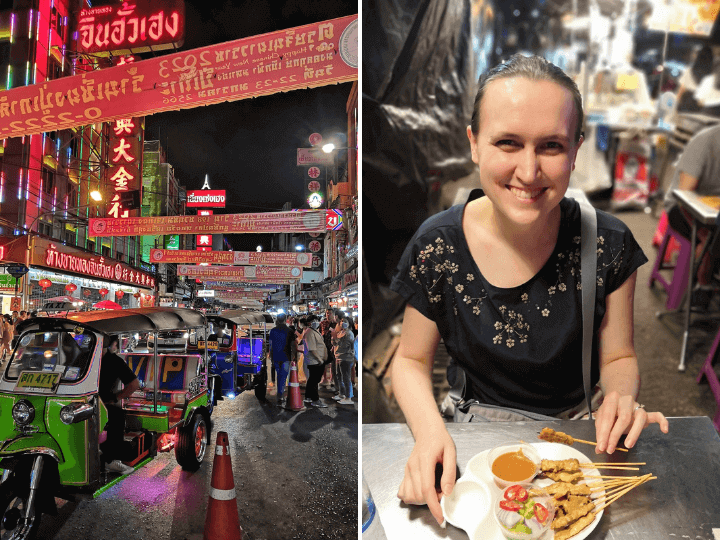
Chinatown, also known as Yaowarat, another great reason why Bangkok is worth visiting. It is home to some of the best street food in the city. However, there is more to this area than just the (amazing) food.
One of the largest in the world, Bangkok’s Chinatown boasts a rich history. It began its life in the late 18th century as Chinese settlers began to arrive in the area. Since then, Chinatown has become a busy commercial centre packed with markets and shops selling everything from traditional Chinese medicine to gold to amulets.
Visitors to the area can wander Chinatown’s alleyways, marvel at elaborate Chinese temples and simply take in the unique blend of the Thai and Chinese cultures. The area also boasts a few great bars where you can take a break from the hustle and bustle of the neighbourhood. Check out the Grand China Princess Hotel Rooftop Bar offering cocktails and views over the Chao Phraya River.
Chinatown comes into its own after dark. This is when Yaowarat Road, the area’s main artery, comes to life with numerous street stalls. Be prepared for crowds and queues as Chinatown is popular with tourists and locals alike.
To make the most of the foods on offer, simply take a wander along Yaowarat Road and nearby streets. Don’t be afraid to try out a few things from different street vendors. From delicious seafood and traditional skewers to various dumplings and unusual desserts, there is lots to get through on a foodie night out in Bangkok’s Chinatown.
Getting to Chinatown
Take the Chao Phraya Express Boat to Ratchawong Pier, which is just a short walk away from all the action. Alternatively, the closest MRT station is Hua Lamphong. It’s just a 10-munute walk from the heart of Chinatown.
Guided Tours
Check out these highly rated guided tours if you’d like to make the most of your visit to this bustling neighbourhood:
- Chef Designed Food Tour For 8 Exclusive Guests
- 4-Hour Chinatown Guided Tour
- Discover the Secret of Chinatown with Food Tasting
Amazing Shopping Malls
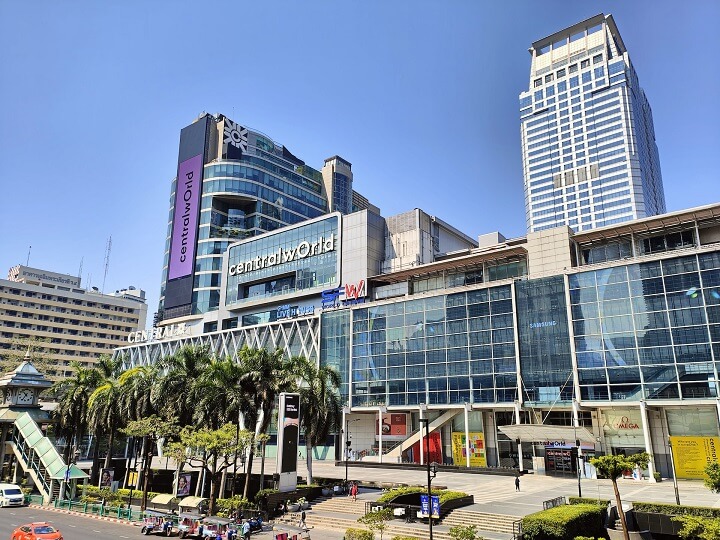
It might seem a little strange to recommend a visit to a shopping mall as part of your trip. After all, most of us are used to bland malls full of chain stores and restaurants that are pretty much the same wherever you go. However, the local shopping malls are something else entirely and are another reason why Bangkok is worth visiting.
Malls have air-conditioning offering an escape from the scorching heat. As a result, they are not a place to just shop, but also socialise. Visitors can enjoy restaurants, spas, cinemas, events and occasionally even ice skating.
Bangkok has many malls on offer. From budget to high end, there is something for everyone. Here are some of the most popular ones to see on your next trip to Bangkok:
- MBK Centre – a huge mall that feels like an indoor market
- Siam Discovery – just opposite MBK, this concept mall focuses on lifestyles brands including fashion and homewares from Thai designers
- Siam Paragon – one of the largest and most famous malls in the Thai capital
- CentralWorld – a huge mall that is home to many international brands and an indoor ice rink
- ICONSIAM – a spectacular high-end mall located on the Thonburi side of the Chao Phraya River.
Make sure that you take advantage of the food courts when visiting Bangkok malls. Although you will occasionally find chains like McDonalds there, they also have stalls serving delicious and affordable Thai and international food. Shopping mall dining is not just for tourists; locals make the most of it too.
Fascinating Floating Markets
Floating markets are another reason why Bangkok is worth visiting, and are the city’s most popular attractions. Located along canals, also known as khlongs, these markets feature vendors selling a variety of wares from their boats, including food, crafts, and flowers.
These markets are renowned for their colour, vibrancy, and unique atmosphere. The best way to experience them is by taking a boat, from which you can browse and shop. Some vendors even cook food right on their boats, allowing you to enjoy a delicious Thai meal at the market.
Unfortunately, some floating markets have become victims of their own success, attracting huge tourist crowds that can sometimes detract from the experience. However, you can avoid the crowds by visiting the lesser-known markets.
The most popular floating market is Damnoen Saduak, located in Ratchaburi province. Although it’s fun to visit, it can get quite busy. Other great options with fewer crowds include Amphawa Floating Market, famous for its seafood, and the Khlong Lat Mayom and Taling Chan markets, which are located close to each other and still mostly frequented by locals.
Most markets are located just outside Bangkok, in the nearby provinces. Travelling to them takes some time, so allow for at least half a day. There are many organised tours available that will take you to the most popular markets and other attractions.
Here is a selection of some highly rated day trips:
- Damnoen Saduak Market and Maeklong Railway Market
- Grand Palace, Damnoen Floating Market & Maeklong Market Tour
- Damnoen Saduak, Train Market & Mahanakhon Day Trip
Dazzling Rooftop Bars
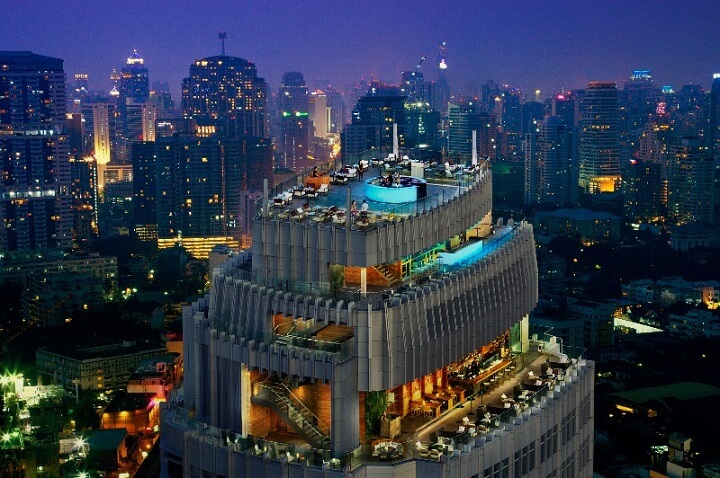
Thanks to Bangkok’s many high-rises and possibly relaxed building regulations, the city is home to dozens of rooftop bars. Enjoying a glamorous night out with breath-taking views over the capital is another reason why Bangkok is worth visiting.
One of the most popular options is the aptly called Vertigo located on the 60th floor of the Banyan Tree hotel. You can simply enjoy a cocktail with a view over there or have a proper meal. The menu features a wide selection of seafood and grilled meats.
Another famous spot is Sky Bar at Lebua State Tower. Located on a 63rd floor rooftop terrace, it is one of highest rooftop bars in the world. It offers panoramic 360-degree views over the capital complemented by an extensive cocktail list. This bar was even featured in the Hangover II movie.
Spanning the top four floors of the Bangkok Marriott Hotel Sukhumvit, the chic Octave Rooftop Lounge and Bar offers a romantic setting for drinks and light bites. With incredible views, delicious food and chilled DJ sets, a relaxed night out is guaranteed.
Ultimately, you don’t need to go to the most famous places to have a great night out. There are plenty of rooftop bars to choose from. Many high-rise hotels offer these. Chances are, if you are staying in downtown Bangkok, there will be at least one rooftop bar near you.
Bear in mind though that a visit to a trendy rooftop bar is not a budget Bangkok experience. I also recommend booking your spot in advance to ensure that you don’t miss out.
Delicious Thai Food
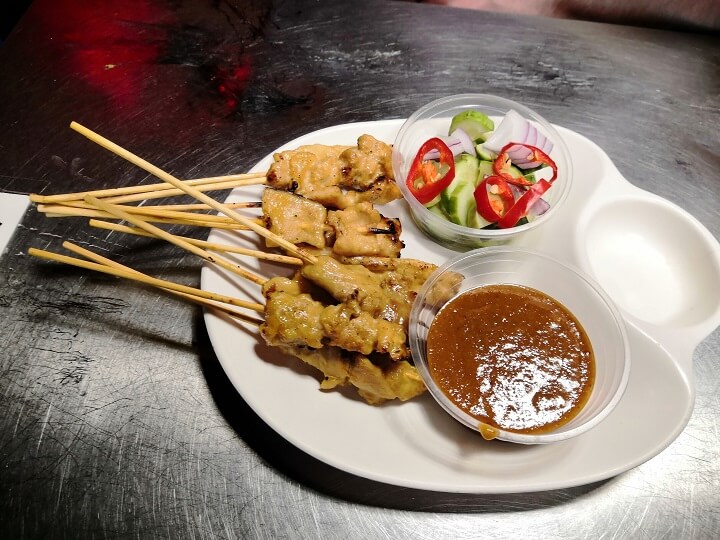
You will be hard-pressed to find an article on why Bangkok is worth visiting that doesn’t mention the city’s culinary credentials. The Thai capital is indeed a city for foodies.
Bangkok is especially famous for its incredible street food scene. It doesn’t exist just for the benefit of tourists. Locals love to grab a snack or a meal from street food vendors too. If you want to experience an authentic dining experience in Bangkok, make sure to try something sold at a street stall.
Some of the most popular areas for street food are Chinatown, Victory Monument, Sukhumvit Soi 38 and Khao San Road. The latter two are quite touristy and the food there is often altered to better suit Western palates. However, you can still get a decent and affordable meal there.
But this list of street food destinations is not exhaustive. There are so many more to discover. The rule of thumb is that if you see a long queue near a stall, chances are it’s worth a try. Don’t be put off by the stalls’ unassuming looks. Some of them are dining institutions that have even been featured in the Michelin guide.
If you’re nowhere near the popular spots, don’t worry. You can spot food vendors pretty much anywhere. Bear in mind that Mondays are the days when many street food vendors stay at home. This is when you might be better off enjoying a meal at a restaurant.
However, Bangkok’s food wonders are not limited to street food. At the other end of the scales is the city’s fine dining offering. Bangkok is home to 34 Michelin-starred restaurants that serve everything from a modern take on Thai cuisine to classic French fare.
Guided Tours
If you would like some help in navigating Bangkok’s food scene, check out on these top-rated food tours.
- Michelin Guide Street Food Tour by Tuk Tuk
- Chef Designed Food Tour For 8 Exclusive Guests
- Midnight Food Tour by Tuk-Tuk
Romantic Cruises Along the Chao Phraya River
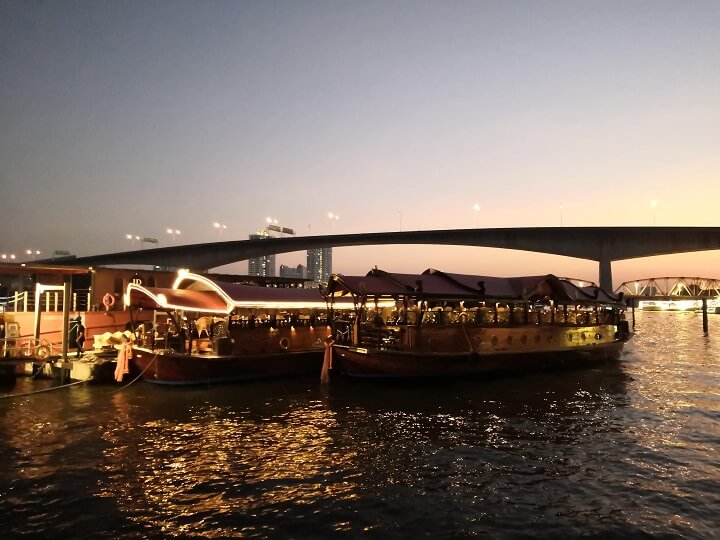
If you would like to see Bangkok from a different perspective, take a cruise along the Chao Phraya River. This is my personal favourite reason for why Bangkok is worth visiting.
The river is the city’s main waterway used for transporting people and good. Its banks are lined with famous sights and brand-new residential developments.
Evening Chao Phraya River cruises are a great way to see the beautifully lit historic landmarks and the busy riverside life. You can basically see Bangkok’s past and present coming together. Popular cruises feature a buffet dinner and live music. Here are a couple of cruise options you can book online:
However, for something different, I highly recommend Manohra Cruises. These depart from the Anantara Riverside Bangkok Resort pier. Don’t worry, you don’t need to stay at the hotel to go on this cruise.
Manohra Cruises offer an intimate 5-course fine dining experience served up on an elegant antique rice barge. The barges are much smaller than the mainstream boat options, so you can enjoy your meal in a peaceful atmosphere. The food itself is a creative take on Thai classics made of locally sourced ingredients. It is delicious and plentiful. I wouldn’t hesitate to do this cruise again.
Please note that the Manohra Cruise experience is on the pricier side. A dinner with alcoholic drinks costs 3,900 Baht ($110 US) per person. If you are happy with soft drinks, then the cost is 2,900 Baht ($83 US) per person. You can book your table on the Manohra Cruise website.
Infamous Khao San Road

Full disclosure, I have mixed feelings about Khao San Road. The reason why it’s featured in this guide on why Bangkok is worth visiting is because it’s one of those places you should experience for yourself and form on your own opinion.
Khao San Road is probably one of the most famous tourist streets in Bangkok. It’s been attracting budget travellers and backpackers for decades. Today, Khao San Road is a curious blend of Thai and Western elements. It’s like a slice of Thailand that’s adapted to the Westerns expectations of what a Thai experience should be.
It is packed with hostels, cheap bars, street food stalls, souvenir shops and massage parlours. Vendors, bar staff and tuk-tuk drivers can be quite pushy, but it’s fine to simply say no to them. Khao San Road exists pretty much for tourists, offering something different to what you’d find at home without causing a severe culture shock.
However, Khao San is also incredibly lively at night. It attracts people from all over the world, from backpackers on their gap year to families on holiday. It is the place to enjoy an affordable night out, load up on cheap clothes and meet other travellers. The key to enjoying it is not taking your surroundings too seriously.
Also, don’t be afraid to check out the area just beyond Khao San Road. There are museums, art galleries, excellent street food vendors and bars frequented by locals just a short walk. It’s quite amazing how this street exists in its own little bubble.
Getting to Khao San Road
Khao San Road is not well-connected when it comes to public transport. If you are not taking a taxi or a tuk-tuk, the best option is to take the Chao Phraya Express boat to Phra Arthit Pier. From there, it’s a 10-minute walk to all the action.
Tranquillity of Lumphini Park

Bangkok is known as a concrete jungle. However, the city has some beautiful green spaces where you can escape the chaos of the city.
Lumphini Park, an oasis of calm in the Silom district, is the jewel in the city’s crown and another reason why Bangkok is worth visiting. It’s been nicknamed Bangkok’s Central Park due to its size and location surrounded by high-rises and busy roads.
Established in 1925, Lumphini Park is Bangkok’s oldest public park. The land that the park now occupies used to be a royal estate. King Rama VI gifted it to the people to establish first a fairground and then a public park. It was named after Lumbini, the Buddha’s birthplace in Nepal.
Today, you can take a stroll along Lumphini Park’s pathways, relax in the shade of palm trees or hire a kayak or a swan paddle boat to enjoy the park’s artificial lakes. Locals come to the park to jog, cycle and take advantage of its various exercise facilities from outdoor gym equipment to tennis courts.
Lumphini Park is also a great place for wildlife watching. It is home to turtles, birds and monitor lizards. The latter are related to Komodo dragons, so they are rather scary looking. As long as you don’t bother them, they are perfectly fine to be around.
If you are feeling peckish, there are a few shops and food stalls scattered around the park. Keep in mind that many street food vendors are closed on Monday. If you are heading to Lumphini Park then, grab a picnic with you. There are plenty of seating and picnic tables in the park. Alternatively, the nearby Silom area is packed to the brim with great food options.
Getting to Lumphini Park
The closest BTS Skytrain station is Sala Daeng. There is also the Silom MRT station right with an exit right at the park.
Relaxing Thai Massages
No visit to the Thai capital would be complete without experiencing a Thai massage. Bangkok is worth visiting for this relaxation practice alone.
It’s a traditional wellness discipline that has been around for millennia. It focuses on Sen, the energy lines in the body, through which your life energy flows. The purpose of the massage is to balance these out and let the energy flow freely.
Thai massage combines yoga-like stretching and acupressure techniques to promote relaxation and reduce tension in the body. It’s even been nicknamed the lazy person’s yoga as your massage therapist guides your body though all the movements. It is oil-free and can be a little intense. You do feel quite relaxed afterwards though.
Bangkok is home to hundreds, if not thousands, Thai massage parlours. Chances are, there will be a few options near your accommodation. Traditional parlours are quite affordable by Western standards. If you want to experience it at a high-end spa, the prices will be much higher.
To choose a massage parlour, have a look at online reviews. Popular places, especially near large hotels, will often have a social media presence and Google reviews. Traditional massage parlours often look old and tired, but don’t let that stop you. Just make sure that the place looks clean and well-maintained.
I also recommend having a Thai foot massage. It applies reflexology techniques on specific points of the feet. It’s not quite as intense as the full-body Thai massage, but deep relaxation is guaranteed.
Hub for Thailand and South East Asia Travel
Bangkok is also worth visiting as part of a bigger South East Asia adventure. It is one of the key economic hubs of South East Asia, so it’s not surprising that it is extremely well-connected to other parts of Thailand and beyond.
The city boasts two international airports that receive flights from all over the world. As a result, Bangkok is often the first point of entry into Thailand for many travellers.
There are also several railway stations and bus terminals that visitors can use for further travel. These connect Bangkok to other parts of Thailand, as well as to some neighbouring countries.
Unsurprisingly, many travellers use Bangkok as a hub for exploring the wider South East Asia region. You can easily travel to and from places like Cambodia, Vietnam and Laos and back from the Thai capital.
If you are travelling to different regions of Thailand, like travelling from North to South, you may also find yourself passing through Bangkok multiple times.
Hot All Year Round
If you are like me, and you don’t enjoy cold weather, Bangkok is worth visiting for it’s all year round warmth. This destination doesn’t really experience a classic winter. Due to Thailand’s tropical climate, Bangkok is pleasantly warm all year round.
There are three seasons in Bangkok: the cool season that runs from November to March, the hot season between March and May, and the wet season from June to October.
The term ‘cool’ season is somewhat deceptive – the average temperature in Bangkok is about 28°C (82.4°F) during this period. This is also when the city enjoys the least rain and humidity. During the hot season, average temperatures rise to above 30°C (86°F).
The average temperature during the wet season is around 29°C (84.2°F). However, this is also the time of high humidity and the heaviest rainfall. It does, however, offer some respite from the heat.
So, as you can see, Bangkok enjoys consistently high temperatures throughout the year, making it an appealing option for escaping the cold North American or European winters.
Convenient and Easy to Travel
Bangkok is also worth visiting because it boasts a developed and relatively easy-to-navigate transport network, making travel around the city a breeze. It consists of the BTS Skytrain, metro, ferries, and buses – you can find more information on the Bangkok transport system in the ‘How to get around’ section below.
Away from transport, I’ve found that Bangkok is generally a great entry point for travelling in Asia. Although it still provides a culture shock, it also offers many of the comforts travellers are familiar with from home. Many other parts of Asia might be more of a shock to the system.
Although cash is still widely used in Thailand, you’ll find that hotels, shopping malls, many tourist attractions, and higher-end cafes and restaurants now all accept cards. However, be sure to keep enough cash on hand for taxis, public transport, and street food.
I’ve also found that, even though some language barrier exists, most people you’ll interact with will have at least a basic command of English. Additionally, most people are friendly and willing to help. Unfortunately, you may encounter scammers who take advantage of tourists, but they are very much in the minority.
The Cons of Visiting Bangkok
Although I strongly believe that Bangkok is worth visiting, the city has a few cons that are worth being aware of when you travel there. Being informed about these will help you be more prepared to make the most of your trip.
Bangkok is Chaotic and Overwhelming
Bangkok is home to over 11 million people and covers a vast area. Many visitors find the city overwhelming due to the big distances, crowds, endless flows of cars and scooters, and often haphazard urban planning.
However, once you understand how the city works and become familiar with the main neighbourhoods, Bangkok will feel a lot more manageable. You’ll also be able to find many quieter corners.
Also, the key historic attractions, such as the Grand Palace and Wat Pho, are concentrated in a relatively small area. So, if you are mainly focusing on those during your trip, you won’t need to cover much ground.
Busy Roads
Bangkok’s reputation for busy, chaotic roads is well-deserved. The city’s main arteries are packed with cars and scooters.
Drivers and riders can often act aggressively and don’t always follow the rules. Traffic jams in Bangkok can be brutal as well.
That’s why tourists are generally advised not to drive in Bangkok. The city’s excellent transport system covers most travellers’ needs. Also, be extremely careful when crossing the road – not everyone respects zebra crossings and even red lights.
Pollution
With vehicle emissions, traffic congestion, and open waste burning, Bangkok has a high level of air pollution. The current PM2.5 concentration, which measures particle pollution in the air, in Bangkok is significantly above the WHO’s recommended limit.
Although short-term exposure to this level of pollution is unlikely to affect you, living in this environment long-term can be detrimental to a person’s health. If you have a respiratory condition, be aware that a visit to the city may worsen it.
Scams
One of my least favourite things about Bangkok is the scammers who try to take advantage of tourists. A common scam involves a friendly man approaching you near a popular attraction, informing you that the attraction is closed, and then directing you to a tuk-tuk for a ‘tour’ often leading to dodgy gem sellers.
If you are approached in this manner, politely remove yourself from the conversation. Also, trust your gut instincts – if someone feels dodgy, they probably are.
There are many other types of scams as well, so you need to be cautious. Try to book tours and experiences through licensed operators and trust official attraction opening times.
Dodgy Taxi Drivers
Bangkok taxi drivers are notorious for unethical practices, often trying to inflate the price of a trip. Ideally, you should ask them to use the meter. In practice, they often refuse. Be vigilant about ensuring you receive the correct change back.
If a taxi driver suggests taking you on a tour, politely decline. Chances are, this is another scam that will take you to dodgy gem and souvenir stores.
Thankfully, you can now avoid many taxi hassles in Bangkok by using the Grab app, Thailand’s Uber.
No Beaches
If you are hoping to go to the beach while in Bangkok, you will be disappointed as the city doesn’t have any. However, within a couple of hours’ drive from the city, there are a few beach destinations, such as Hua Hin, that are popular among both tourists and locals.
Heat and Humidity
Although I did say that Bangkok’s heat as a reason why the city is a great destination, I appreciate that not everyone will find the heat comfortable. Although the ‘cool’ season is manageable when it comes to temperatures, the heat and humidity of the hot season can be too intense for some.
The Best Time to Go to Bangkok
Bangkok is worth visiting all year round since it is a huge city with plenty to see and do there. It has a tropical climate, so it’s pretty much always warm and humid. November to March are the driest and coolest months with only an occasional tropical shower.
With an average of 28⁰C, this time of the year offers the most comfortable temperatures for sightseeing. Not surprisingly, these five months are also the high season, so book your accommodation in advance and be prepared for crowds at popular tourist spots.
From April to October, temperatures and humidity levels increase. Weather becomes more unpredictable with frequent showers. Although this is the time of the year when you can enjoy Bangkok with fewer crowds, you might find it difficult to be out and about in intense heat.
How to Get to Bangkok
If you are travelling from overseas, you are mostly likely going to land at Suvarnabhumi airport (BKK), Bangkok’s main airport. It is also a hub for domestic flights.
The most affordable way to get into the city from there is by either bus or train. A bus ticket costs 35 baht ($1 US) and the full list of bus routes is available here. The train fare is between 15–45 baht depending on how far you are going. The Bangkok Airport Rail Link page has the most up-to-date information on the route, schedule and fares.
Bangkok is also home to another airport, Don Mueang International Airport. This smaller airport receives flights from other parts of Thailand. It is also a hub for low-cost carriers from the Southeast Asia region.
Public buses and a train link connect the Don Mueang Airport with Bangkok. The airport website (non-official) has information pages on bus services and the train.
A more convenient, but pricier way to travel from the airports into the city is by taxi. If you would like to book an airport transfer in advance, you can do so with Welcome Pickups. This will reduce the hassle on arrival and get you to your accommodation as quickly as possible.
How to Get Around Bangkok
Bangkok is vast and although individual neighbourhoods are walkable, you will most likely need to take some form of transport to get around.
Bangkok is notorious for its horrendous traffic, especially in rush hour. That’s why renting a car is usually not recommended. Thankfully, Bangkok is home to an efficient public transport system. While not perfect by any means, it will get you to most popular city sights.
BTS Skytrain
The BTS Skytrain, an elevated train network that covers a portion of central Bangkok is a popular way to get around. The carriages are clean and air-conditioned and not too busy unless you are travelling in rush hour.
There are two BTS Skytrain lines, Sukhumvit and Silom, that operate in Bangkok’s modern business district. You can use them to access night markets, shopping malls, Lumphini Park and more. The official BTS website has the most up-to-date information on timetables, routes and fares.
By Thai standards, BTS Skytrain is not a cheap mode of transport. However, for many overseas visitors it is quite affordable.
Underground Train (MRT)
MRT is a network of underground trains. It consists of two lines, the Blue Line and the Purple Line. MRT connects to BTS Skytrain via the Asok station.
MRT is a modern, air-conditioned transport system that is relatively easy to navigate. As well as the business district, MRT covers some sections of the old town. For example, you can use it to get to Chinatown and the Grand Palace.
Plan your journey and check ticket prices on the MRT website.
Bus
With fares starting from just 8 baht ($0.23 US), the bus network offers an affordable way to get around Bangkok. With over 100 routes on offer, trying to figure the system out as a first timer can be overwhelming.
Buses connect the city to the suburbs and are popular with locals. For tourists though, a bus ride might be a shock to the system. From obnoxious driving to the absence of air-conditioning on many buses, it might not always be the nicest experience. However, it’s probably one of the more ‘local’ ways to get around Bangkok.
You can find the full list of available routes on the Bangkok Mass Transit Authority website. Be prepared that signage on buses is in Thai. Also, make sure you have small change for the fare.
Taxi
Bangkok taxis are affordable by Western standards and can be a convenient way to travel, unless you’re stuck in rush hour traffic.
For the best rates, hail a taxi in the street and make sure the meter is on. Taxi drivers will often try to offer a fixed price which is normally much higher than it should be. You need cash to pay for the journey. Make sure to check if you’ve been given the right amount of change before you leave the car.
Alternatively, use can use Grab, an Asian version of the Uber app. Motorbike taxis are also an option. Personally, I’m a bit too scared to take those.
Tuk-Tuk
Taking a tuk-tuk ride is practically a rite of passage for Bangkok visitors. Tuk-tuks are motorised three-wheeled rickshaws. You will often see a bunch of them hanging out near hotels and popular tourist spots like Chinatown and Khao San Road. Locals use them too, for short-distance rides or to transport goods.
To get a tuk-tuk, you can simply hail one on the street. Be prepared to haggle though as tuk-tuk drivers normally inflate prices for tourists. You will probably end up paying more than a local would no matter what, but it’s still going to be relatively cheap overall.
Be aware, that some tuk-tuk drivers may try to scam you. For example, a driver may offer a cheap tour of the city. However, instead, he will take you to shops where he makes a commission from purchases. If you are offered something along these lines, politely decline.
Boat
My favourite way of getting around Bangkok is by boat. If you are staying near the Chao Phraya River, you can hop on either the Chao Phraya Express or the Chao Phraya Tourist Boat. The former has more extensive routes, but for the purposes of sight-seeing, both are just fine.
Bangkok’s most famous attractions such as the Grand Palace, Wat Arun, Chinatown and Khao San Road are all easily accessible from the river. Travelling by boat also allows you to take in the riverside life in while enjoying a pleasant breeze.
Where to Stay in Bangkok
Bangkok is made up of diverse neighbourhoods and visitors are spoilt for choice when it comes to accommodation options. From affordable guest houses in historic areas to uber-luxe resorts by the river, the Thai capital caters to every budget.
Here is a list of areas of Bangkok that work especially well as a base for travellers. They all have a different feel and will reveal a different side of the city during your stay.
For a more detailed review of different neighbourhoods, check out this guide to the best areas to stay in Bangkok.
Rattanakosin Island
Rattanakosin Island, also known as the Old City, is Bangkok’s historic centre. It is home to the Grand Palace and Wat Pho. Rattanakosin is a great option for those looking to be as close as possible to the city’s most famous historic sights. If you choose to stay there, you will also have easy access to the river pier for the Chao Phraya Express and Tourist boats as well as MRT.
Here are some hotel suggestions:
- Budget: Siri Heritage Bangkok Hotel
- Mid-Range: Riva Arun Bangkok
- Luxury: 1905 Heritage Corner
Banglamphu
Just north of Rattanakosin Island lies Banglamphu, another historic area of Bangkok. It is popular with backpackers as this is where you’ll find the infamous Khao San Road. But there’s more to Banglamphu than its most famous spot.
If you venture beyond it, you will discover eclectic streets with an old Bangkok feel. They are lined with quaint cafes, antique shops and trendy bars that are frequented by both Thais and locals. There are also a few markets and historic temples to explore.
In terms of connectivity, the best way to get to other areas is by river via the Chao Phraya Express or Tourist boats. There are no BTS Skytrain or MRT stations there.
Here are some hotel suggestions. Bear in mind that Banglamphu isn’t really a place for high-end hotels.
- Budget: Lamphuhouse Bangkok
- Mid-Range: Chillax Resort
Sukhumvit
For a modern Bangkok experience, check out Sukhumvit. Stretching along Sukhumvit Road, this cosmopolitan area is popular with tourists and expats. It is home to shopping malls, excellent restaurants, popular rooftop bars, trendy nightclubs and international hotel chains.
The area is well connected and boasts many MRT and BTS Skytrain stations. Sukhumvit is a great option if you’d like to easily get to other parts of the city.
Here are some hotel suggestions:
- Budget: Hide and Seek Boutique Hometel
- Mid-Range: Rembrandt Hotel and Suites
- Luxury: 137 Pillars Suites Bangkok
Silom
Silom is Bangkok’s centrally located financial district, so expect high-rises, high-end shopping and trendy bars. Visitors can also enjoy a great selection of eateries, from street food to fine dining. But it’s not all about glass and concrete as Lumphini Park is located in Silom too.
If you are looking to explore other areas of Bangkok, Silom would be a good choice thanks to its MRT and BTS Skytrain connections. The latter can quickly get you to Sathorn pier so you can hop on the Chao Phraya Express or Tourist boats to visit Bangkok’s historic neighbourhoods.
Here are some hotel suggestions:
- Budget: Amber Boutique Silom
- Mid-Range: Amara Bangkok Hotel
- Luxury: The Standard, Bangkok Mahanakhon
Riverside
If you would like to experience a more relaxing side of the Thai capital, Bangkok’s Riverside is for you. Many hotels located on the banks of the Chao Phraya River offer incredible views over the city, away from the chaos of the most central areas. Also, cultural sites such as The Grand Palace and Wat Arun are easily accessible from the river.
Staying there also means making the most of the river transport. Many hotels offer free shuttle boats that will help you get to other parts of the city. However, if you’re into nightlife or want to spend as little time in public transport as possible, I recommend choosing to stay somewhere else.
Here are some hotel suggestions. Please note, Riverside is not the most budget area of Bangkok.
- Budget: Theatre Residence
- Mid-Range: Anantara Riverside Bangkok Resort
- Luxury: Mandarin Oriental Bangkok
My husband and I stayed a Anantara Riverside Bangkok Resort on our honeymoon. Check out my review of this excellent hotel.
Final Thoughts
I hope this guide on why Bangkok is worth visiting will inspire you to visit this incredible city. Chances are that one trip is not going to be enough to really get under its skin.
To help you plan your adventure, I’ve put together a one-day and two-day itineraries in Bangkok. They cover the city’s iconic attractions and will work especially well for first-time visitors.
If are looking to combine a visit to Bangkok with an adventure in Phuket, check out this guide on what Thailand’s biggest island has to offer. Phuket is especially great for couples, and if you are heading there with your other half, here are some suggestions on the best areas to stay on the island for a romantic getaway.
FAQs: Is Bangkok Worth Visiting?
As a minimum, I recommend spending at least two days in Bangkok. It should be enough to see the Thai’s capital most famous sites and neighbourhoods. However, I think allowing for between 3 to 5 days in the city will give you more time to explore the city.
Bangkok is fascinating megapolis famous for its street food, nightlife, historic attractions and shopping. It is also a city of contrasts where modern life and traditions collide in curious ways. Although it’s very much on the beaten path, Bangkok’s popularity is well-deserved.
Yes, Bangkok has a large tourist industry, and the people are generally friendly towards visitors. However, there are some scammers out there who don’t have your best interests in mind. If someone feels dodgy, politely remove yourself from the situation.
If you are coming from a wealthy country with a strong currency, you will find Bangkok quite affordable. Your money will stretch further, and you’ll be able to enjoy many luxuries for less. This might not be the case if you are coming from a country with a lower purchasing power.
Overall, Bangkok is a relatively safe destination for tourists. However, you need to be as cautious and aware of your surroundings as you would in any other major city. Violent crime is rare in Bangkok, but petty crimes such as pickpocketing and scams are common. Additionally, the city has experienced some violent protests in the past. So, if you happen to be there during any such disturbances, stay away from them altogether.
Enjoyed this guide on why Bangkok is worth visiting? Bookmark or pin it for later.
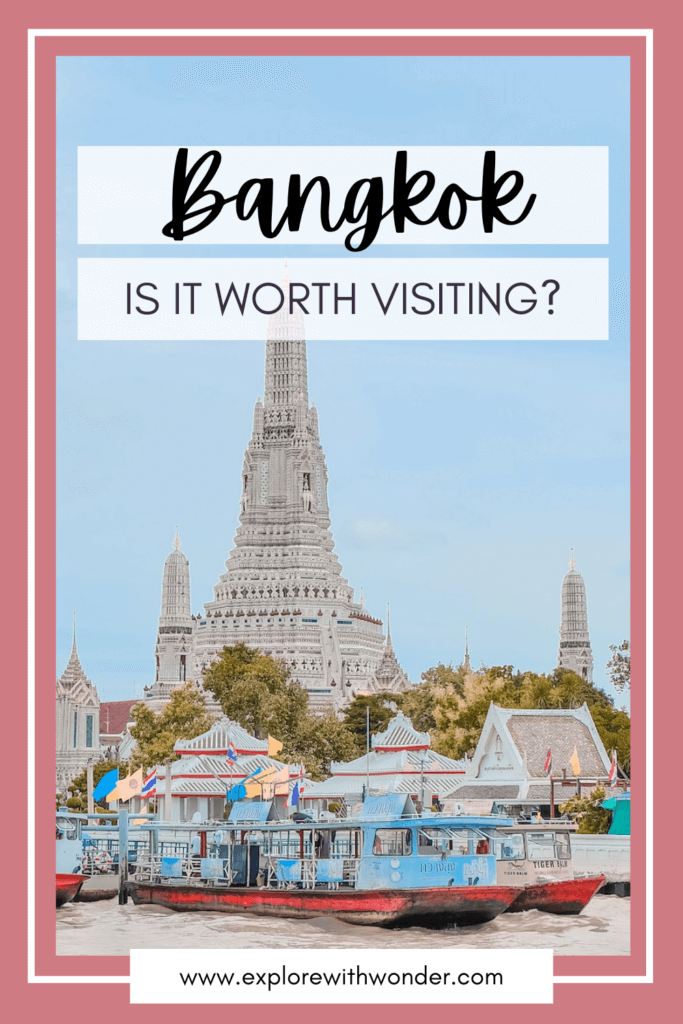
Related Reads: Thailand
- Is Thailand Worth Visiting in 2024? 17 Best Reasons to Visit Thailand
- What is Thailand Famous for? 23 Things You Need to Know
- Phuket or Bangkok: Which Should You Visit?
- Best Areas to Stay in Bangkok in 2024
- 2 Days in Bangkok, Thailand: The Definitive Travel Itinerary
- 24 Hours in Bangkok: The Ultimate Itinerary
- Anantara Riverside Bangkok Resort Review
- Is Phuket Worth Visiting? 10 Reasons to Visit Phuket
- Phuket in December: Everything You Need to Know in 2024
- Where to Stay in Phuket for Couples: The Best Areas and Hotels
- Why is Thailand So Cheap? Cost of Travel to Thailand in 2024
- Is There Uber in Thailand in 2024? Everything You Need to Know
- Does It Snow in Thailand? Everything You Need to Know

